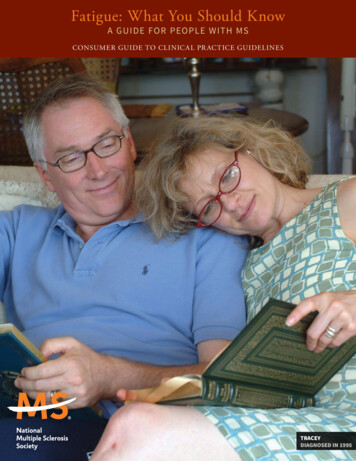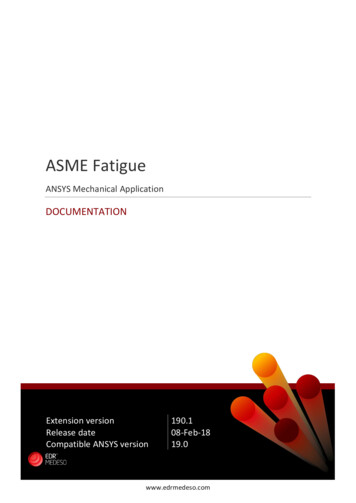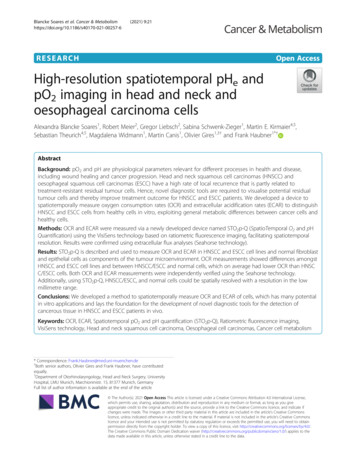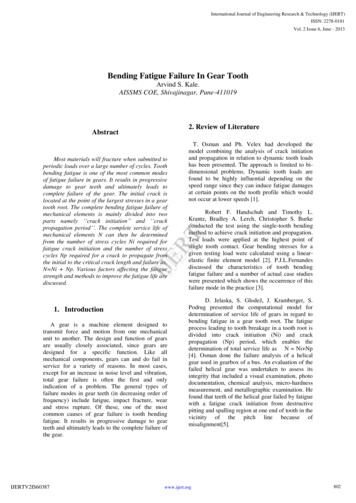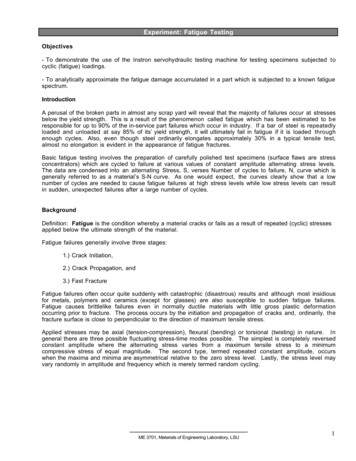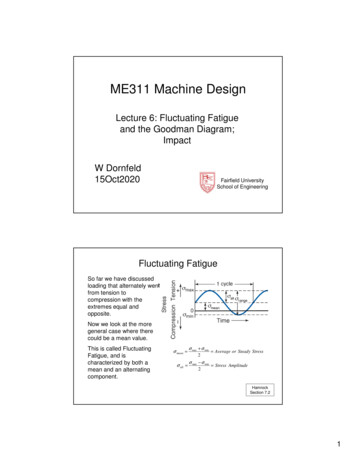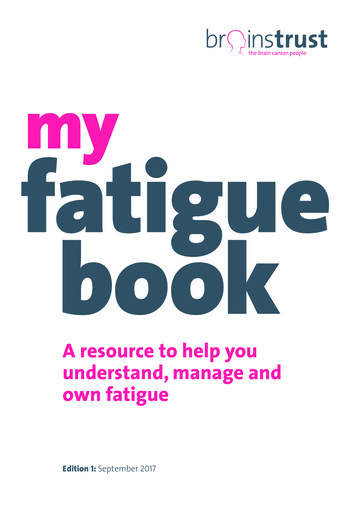
Transcription
myfatiguebookA resource to help youunderstand, manage andown fatigueEdition 1: September 2017
ContentsAbout this resource1What this resource aims to do1Part 1: Understanding fatigue3What we mean by fatigue4Causes of fatigue4What is different about fatigue for people living witha brain tumour?5How do we measure fatigue?8Coping with fatigue in different contexts9Part 2: Building my fatigue toolkit11How does this resource work?12Analysing your fatigue13Where to begin?14Using a fatigue diary14Dealing with things that don’t help your fatigue16Sleep hygiene16Managing your fatigue17Goal setting: I can’t do that here17Self-activation strategies:21 Relaxation (breathing, physical relaxation)22 Mindfulness23 Learning a new pace of living23 Creating a sanctuary26 Prioritising26 Activity scheduling27my fatigue booki
Contentsii Pleasurable activities28 Organising your environment28 Acceptance29 Exercise32 Rest33 Diet34 Drug treatments for fatigue34Looking after someone who has fatigue35Who can help?36Questions to ask36My toolkit37Fatigue Diary37Dealing with things that don’t help your fatigue38Sleep hygiene – how clean is yours?41Why do you want to have less fatigue and managethe fatigue that you do have?43What makes your heart sing?46The Brief Fatigue Inventory47References50Useful Links52My notes53my fatigue book
IntroductionINTRODUCTIONAbout this resourceI thought I knew what it meant to be tired. I now know I had no idea. This isn’t just being tired. This saps at your identity,your confidence, your way of being. I don’t go out anymore.I avoid leaving the house, I don’t shop, friends have stoppedasking me out.Patient We know that fatigue is one of the biggest challenges facingpatients and caregivers who are living with a brain tumour – youhave told us it is. Not only that, but research1, 2 also tells us it is.It is one of the key themes that have emerged from our dailyinteractions with everyone in our brain tumour community,whether they are a patient, a caregiver, a clinician, a nurse or anallied health professional.And we know too that fatigue caused by a brain tumour andtreatment can be very different from fatigue caused by othercancers. More on this later.What this resource aims to doThis is an informative resource written to enable patients andcaregivers living with a brain tumour to understand what is meantby fatigue and to self-manage fatigue relating to brain tumours sothat they: learn a new pace of living take steps to mitigate the impact of fatigue make the most of what they can do, rather than what they can’t.1Grant, R. et al. (2015). Top 10 priorities for clinical research in primary brain and spinal cordtumors. [pdf] London: James Lind Alliance. Available at: http://www.neuro-oncology.org.uk/jla/docs/JLA PSP in Neuro-Oncology Final Report June 2015.pdf [Accessed20 May 2017].2 Day, J. et al. (2016). Interventions for the management of fatigue in adults with a primarybrain tumour. Cochrane Database Systematic Review.my fatigue book1
IntroductionINTRODUCTIONIt provides an overview, along with suggestions for copingstrategies. It is a game of two halves. The first half provides thebackground for fatigue – what we mean by fatigue, why patientsget fatigued and the challenges of living with fatigue as patientsand as caregivers. By becoming familiar with this resource, youshould come away knowing more about: what we mean by fatigue the causes of fatigue what is different about fatigue for people living witha brain tumour how we measure fatigue coping with fatigue in different contexts.The second half is about building a personalised fatigue toolkitto help you manage fatigue so that your quality of life improves.Building my fatigue toolkit covers: using a fatigue diary sleep hygiene self-activation strategies (such as relaxation, mindfulness,prioritising, activity scheduling, acceptance, exercise) goal setting drug treatments for fatigue looking after someone who has fatigue who can help questions to ask.As ever, if you have any concerns, do ask your healthcareteam for advice.2my fatigue book
Part 1:Understandingfatigue
Part 1: Understanding fatigueWhat we mean by fatigueFatigue is a physical, emotional and/or mental tiredness that doesnot go away completely. It is often experienced as overwhelming.It is very different from everyday tiredness because it lasts longerand can come on without a warning. It has a big influence oneveryday activities and can make even small chores or routinetasks seem impossible to do.PART 1I would have a shower and then have to go back to bed. I just couldn’t do anything more. PatientFatigue can last for a very long time (months to years), even aftercompleting treatment for a brain tumour. Fatigue is known to beone of the most difficult side-effects of brain injury and cancertreatment. It is not known exactly how many people living with abrain tumour suffer from fatigue, but it is estimated that between40% and 80% of people with a brain tumour experience severefatigue3, 4.Causes of fatigueWe don’t know the precise causes of fatigue. Because of thephysical, emotional and mental aspects of fatigue, the causeis likely a combination of factors (also called multifactorial).Chemotherapy and radiation therapy can cause fatigue, butthere is not much evidence to suggest that a brain tumour orits location alone can cause fatigue. It may just be that there isa problem in the brain that is causing fatigue. Fatigue can beassociated with any brain injury, whatever the cause (e.g. stroke,trauma, inflammation or tumour) and wherever the location3 Struik, K. et al. (2009). Fatigue in low grade glioma. Journal of Neuro-oncology, 92(1),pp. 73–78.4 Valko, P. et al. (2015). Prevalence and predictors of fatigue in glioblastoma: a prospectivestudy. Neuro Oncology, 17(2), pp. 274–281.4my fatigue book
Part 1: Understanding fatiguewithin the brain. On top of that, pain and certain medications, suchas anti-epileptic drugs, can cause fatigue. Emotional side-effectsof any cancer treatment, such as worrying, feeling anxious anddepressed and having trouble sleeping, can make fatigue evenworse. If you think you have fatigue, you should have a thoroughmedical evaluation to identify possible reasons for this. Sometimesaddressing other issues can reduce or even eliminate fatigue.PART 1What is different about fatigue forpeople living with a brain tumour?Because fatigue is common after cancer and after brain injury,people living with a brain tumour may be especially vulnerable tofatigue. People living with a brain tumour are much more likelyto be treated with medications that have fatigue as a side-effect,such as anti-epileptic drugs. In addition, people who have livedthrough brain injury often have more trouble processing a lot ofinformation at the same time, for example, when being in a roomwhere more than one person is talking. Social events can becomeexhausting.People living with a brain tumour can also feel drowsy orabnormally sleepy. Although this is related to fatigue, it shouldbe seen as a separate symptom. Drowsiness can be caused by thetumour leading to an increased pressure within the skull, but itmay also be a side-effect of certain medications.Treatment-related causes can include:Surgery and anaesthetics. Fatigue occurs for up to one to twoyears after most major surgeries, not just brain surgery.Radiotherapy. This can cause fatigue at any time during and aftertreatment, including a delayed response. For example, radiotherapycan cause an underactive pituitary gland as a late effect, leading tolow thyroid stimulating hormone or low cortisol production.my fatigue book5
Part 1: Understanding fatigueThe combination of fatigue and the impact on cognition issometimes called ‘beamo-brain’, but it is hard to tease out thesymptoms. For more information about radiotherapy, visitwww.brainstrust.org.uk/radiotherapybookPeople warned me that four to six weeks AFTER the treatment has finished, I would feel really tired. This lasted about a month;PART 1having a shower was a supreme effort and I had to lie downafterwards. A course of radiotherapy is the equivalent to havinganother round of major surgery. Listen to your body. PatientJust how long does the radiation fatigue last? I appreciate everyone is different, but Dean is nearly fifteen months posttreatment and is bone-tired most days. He is tapering his steroids,which we know can be tiring, but he is totally fed up now and sowants to feel more like his old self.Carer6my fatigue book
Part 1: Understanding fatigueChemotherapy. Chemo-brain is a known phenomenon(www.brainstrust.org.uk/chemotherapy). This is a loss of mentalsharpness associated with fatigue. It could manifest itself in aninability to concentrate or multitask.Withdrawal of steroids. Fatigue can be one side-effect of stoppingsteroid treatment, which is why these should never be stoppedabruptly but tapered.PART 1Other factors include:Attentional fatigue. This describes the tiredness that comes fromhaving to focus on behaviours that used to be second nature,such as needing to focus on information or tasks. They were easy;now they require greater effort and concentration and sometimesneed to be relearned. This causes slowed thinking and mentalexhaustion. Learning is hard! Sometimes people lose the ability tofocus on several things at once; being in a noisy or busy place cancause stress, which in turn causes fatigue.Epilepsy, which can come with a brain tumour, causes fatigue.This is due to a range of reasons. For example, sometimes seizuresdisturb sleep patterns. The side-effects of some anti-epilepticmedication can also cause fatigue.A sense of urgency to get things done, trying to live at onehundred miles per hour – these are tiring factors. This sense isheightened with a serious illness, when you believe you might nothave the time ahead that you thought you had.I get tired because when I am having a good day, I try to pack everything in and live every second because it counts. But I can’t dothis anymore, and when I do, I pay for it. Patientmy fatigue book7
Part 1: Understanding fatigueOther factors can include depression, anxiety, physical impairmentor disability, pain, low hormone levels, poor nutrition, dehydrationand infection. Many of these are potentially treatable causes, andaddressing them can relieve fatigue.How do we measure fatigue?PART 1This is tricky to answer. How do you know if you are fatigued andnot simply tired?These are the key signs: feeling anything from mild tiredness to total exhaustion feeling drained resting does not make it go away completely having no energy or strength feeling dizzy or light-headed finding it hard to do routine tasks lacking motivation finding it hard to concentrate finding it hard to think or speak low sex drive finding it hard to cope with life difficulty in managing your feelings.There are other measurement tools that are used by hospitalsfor clinical and research purposes. These include the Brief FatigueInventory and the Fatigue Self-Management Scale. You mightfind it useful to look at the Brief Fatigue Inventory to get an ideaof the kind of questions that you would be asked (Appendix 1).By categorising your levels of fatigue using a 0–10 scale (0 nofatigue, 10 the worst fatigue imaginable) in this kind of tooland keeping a diary, you will be able to see how things improveor become worse over time.8my fatigue book
Part 1: Understanding fatigueA fatigue diary can help you to see patterns in your fatigue.For example, perhaps you notice your fatigue is worse after largemeals or in the afternoon but better after an hour’s rest. Do certainactivities make you more tired than others? It might be helpful tofill in your diary with a healthcare professional or your caregiver.A typical diary can be found in Appendix 2.PART 1Coping with fatigue in differentcontextsWhat does it mean to cope with fatigue? It is pervasive andimpacts in a variety of ways – physical, social, concentrative,emotional, spiritual. All the things that enable us to be whowe are. What does this look like5?Physical: reduced energy level diminished strength or endurance difficulty sleeping.Social: changes in roles or relationships altered responsibilities within the family reduced ability to perform job responsibilities changes in sexual relationships or sexual response reduced interest in affection.5 Conn-Levin, N. (2008). Fatigue and Other Symptoms After Brain Tumour Treatment. [pdf]Ontario: Brain Tumour Foundation of Canada. Available at: df[Accessed 20 May 2017].my fatigue book9
Part 1: Understanding fatigueConcentrative: difficulty concentrating inability to understand new information PART 1 being distracted by sensory input (i.e. noise,activity, etc.)feeling overwhelmed by daily tasksfinding that typical activities of daily living aremore difficult to do.Emotional: changes in mood reduced feelings of self-esteem or confidence diminished sense of control about daily life fears or anxiety about the future concerns about body image changes (i.e. facialdifferences, hair loss, etc.).Spiritual: questioning one’s purposedisinterest in previous religious or spiritualpracticesfeelings of “Why me?” related to diagnosisindifference about prayer, meditation or othermindfulness.You may be fatigued in one or two of these areas or in all ofthem to different degrees. Once you understand how fatigueis impacting on your wellbeing, you can begin to take steps toaddress it.10my fatigue book
Part 2:Building myfatigue toolkit
Part 2: Building my fatigue toolkitI’m four months post op and want to know if this fatigue is part of the recovery? I ask because I spend way more time asleepthan I do awake, and my clumsiness is off the scale at the moment.I can’t help but feel that something is not quite right with me.Patient What follows is a series of checklists, things to do and things to try,that will help you to analyse, identify and manage your fatigue.This will create a toolkit that is personal to you; only you can ownyour fatigue, and therefore only you can work out what it is thatyou need to do. You can, however, ask for help; by building yourtoolkit, you will be more focused in your ask for help.PART 2How does this resource work?We use the principles of marginal gains. In 2010, Dave Brailsfordfaced a tough job. No British cyclist had ever won the Tour deFrance, but as the new General Manager and Performance Directorfor Team Sky (Great Britain’s professional cycling team), that’s whatBrailsford was asked to do. His approach was simple: Brailsfordbelieved in a concept that he referred to as the “aggregation ofmarginal gains”.As with Team Sky, there is no magic wand, no silver bullet thatwill spirit away your fatigue. It’s so easy to overestimate theimportance of one defining moment and underestimate the valueof making better decisions on a daily basis. Almost every habit thatyou have – good or bad – is the result of many small decisions.So if you improve every area related to your sleep by just 1%, thenthe small gains will add up to remarkable improvement. Start byoptimising the obvious things: your environment, adjusting yourpace of living, your habits before you go to bed. Then search for1% improvements in tiny areas that are less obvious and harder todefine. This resource will help you to search, analyse, deal with andmanage your 1% improvements everywhere.12my fatigue book
Part 2: Building my fatigue toolkitAnalyseyour fatigueDeal withthings thatdon’t helpManageany fatiguethat is leftAnalysing your fatigueTreat yourself to a beautiful notebook, one that makes you want topick it up and open it.PART 2Remember that everyone is different. So the way you chooseto manage your fatigue will work for you but probably not forsomeone else. You will find that people will tell you how tomanage it, and this can irritate. You own this – it is your fatigue –and remember they are just trying to be helpful.By analysing your fatigue, you can find strategies to manage it. Butthis on its own can be a daunting, tiring task, so see who can helpyou to do this. And take your time – you don’t have to gather thedata over a day. Take a couple of weeks, or even a month. This wayyou will also have a more comprehensive view ofyour fatigue and how it impacts on your life.Keep a diary, complete the inventory, talkwith your caregiver about what theynotice. For example, if you share abed, your partner may be aware ofthings about your sleep patterns thatyou don’t notice. Complete the diaryevery day for two to four weeks.Make sure you capture the gooddays and the bad days.my fatigue book13
Part 2: Building my fatigue toolkitWhere to begin?You might find it useful to use a scoring system, where 1 reflectsvery low levels of fatigue and 10 where your fatigue is off the scale.These are the things you might want to capture:1. Describe lastnight’s sleep.How well did you sleep?How did you feel when you woke up?Did your partner notice anything about yoursleep patterns?PART 22. Describe youractivities.List your activities during the day. Note howlong the activity lasted and the type of activity.The more detail you include the better.3. Describe howtired you feelwhen you dothe activity.Is it an activity that you coast through, or is itone that you find challenging?4. Add any otherinformationMake a note of other factors you notice thatimpact on your sleep, for example, alcoholmight make you sleepy, getting too hot, eatingcertain foods. Also, log things that have apositive effect, e.g. having a cooler bedroom,being in the dark.Using a fatigue diaryCapture as much information as you can. This will help you toidentify what might be making your fatigue worse or better. Youcan then complete the diary again once you have made changesand compare the two to see if the changes have made a difference.Think about marginal gains – they might seem to be insignificant,but if you make two or three changes, the impact could be big. Tryto give as much information as you can. This will help you identifywhat helps and if there is a pattern.14my fatigue book
Part 2: Building my fatigue toolkitYou can photocopy the diary (it’s also on page 37) so that you haveblanks to complete. Or download it from the brainstrust website Scale of fatigue0 no fatigue10 severe fatigue8.00Showered, ate8. If I couldn’t havebreakfast. Had to got up at all it wouldgo back to bed.have been 10.What helpsAccepting that I amfatigued and showeringat a different point inthe day. Maybe beforeI go to bed.PART 2my fatigue book15
Part 2: Building my fatigue toolkitDealing with things that don’t helpyour fatigueAnalysing your fatigue is the easy bit. Now you have done this, youshould be able to see what is adding to it and making it worse.Sleep hygieneI’m really struggling to sleep, even if I’m exhausted! Even if I do nod off, I only doze really. I’m on a very high dose of Keppra,so do have to be careful. PatientPART 2What disturbs your sleep? It seems counterintuitive to suggestthat sleep may be adding to your fatigue, but lack of sleep may beone cause. Complete the checklist ‘Dealing with things that don’thelp your fatigue’ on pages 38–40. Tick any that apply to you, and,using your 1–10 scale (1 being good, 10 being bad), identify whichones have the most impact. It’s easy to say ‘sleep hygiene’, butharder to achieve it, as it may mean breaking habits of a lifetime.But you have had a life-changing diagnosis; nothing is as it was,so it’s time to adapt. It becomes so easy – so comfortable – to keepcurrent perspectives and opinions on things. But this restricts thecapabilities of the mind, the ability to adapt. If there’s one thinghumans can do, it’s adapt. We’ve been doing it since the beginningof time, and we will never stop.So, what do we mean by sleep hygiene? It’s about the things youdo as bedtime approaches. And these will fall into good and badthings – you will be doing some of both. Use the checklist on pages41–42 to see what you are doing that you need to keep doing, andwhat it is you need to stop doing or change.16my fatigue book
Part 2: Building my fatigue toolkitIdentify three things you will commit to changing. Gift yourselfthese things. These will be your focus for change. Write them here:1 . . . . . . . . . . . . . . . . . . . . . . . . . . . . . . . . . . . . . . . . . . . . . . . . . . . . . . . . . . . . . . . . . . . . . . . . . . . . . . . .2 . . . . . . . . . . . . . . . . . . . . . . . . . . . . . . . . . . . . . . . . . . . . . . . . . . . . . . . . . . . . . . . . . . . . . . . . . . . . . . . .3 . . . . . . . . . . . . . . . . . . . . . . . . . . . . . . . . . . . . . . . . . . . . . . . . . . . . . . . . . . . . . . . . . . . . . . . . . . . . . . . .Of course, your sleeping habits may be fine but you are stillfatigued. What else could you do?Managing your fatiguePART 2Now the work really starts. You can now use your skills, knowledgeand confidence to self-manage your fatigue. The next focus is onself-help measures. You have analysed your sleep, or lack of sleep,and identified the things that don’t help and the things that do.Goal setting: I can’t do that hereWe need to start with appropriate goals that fit with your valuesand context. Let’s start with the why. Why do you want to have lessfatigue and manage the fatigue that you do have?We can create more lasting and sustainable change together, byworking on your purpose, identity, values and beliefs. Have a look atthe pyramid below. These higher levels in the pyramid are generallymore ‘invisible’, harder to change and harder to assess becausethey make you think about your thoughts, emotions and physicalsensations. To make changes, we need to think about whatmotivates you, what would your life be like if you weren’t fatigued,and what you need to do to have that life. Thinking about this willhelp you to explore what’s stopping you making the changes youneed so that you can achieve your goal of being less fatigued.my fatigue book17
Part 2: Building my fatigue toolkitWhat else?PurposeWho?Why?How?IdentityValues and beliefsWhat?Where othatherePART 2You can use this in other areas of your life too. ‘I can’t do that here’can be used to identify what’s stopping you from doing somethingthat is important to you:I identityCan’t values and beliefsDo capabilityThat behaviourHere environmentSit with someone close to you, and ask them to make notes whilstyou answer the questions below. You don’t have to answer all ofthe questions, just the ones that will help you to think about youand your fatigue. Some of these questions might invoke emotion –that’s okay. Emotion shows connection with what you are tryingto achieve.18my fatigue book
Part 2: Building my fatigue toolkitAbout meQuestionsPurposeWhat is life all about?ResponseWhat do I feel compelledto do?What do I want for me?What do I want for my family,friends, children, parents?What’s this all about for me?What must I do?What would be differentfor me?PART 2What do I need to achieve?What would be a good outcomefor me?IdentityWhat’s my role?What have I lost?What’s changed?What has my diagnosis toldme that’s important?What have I learnt aboutmyself since my diagnosis?What’s my role in thefamily now?my fatigue book19
Part 2: Building my fatigue toolkitAbout meQuestionsValues andbeliefsWhat do I now believe?What do I now value?What impact is being fatiguedhaving on things that areimportant to me?How important is it to methat I make changes in my life?Do I allow myself to sleep/rest?CapabilitiesWhat do I need helpwith most?PART 2What information do I have?What information do I need?What haven’t I changed despitehaving the information?When do I feel out ofmy depth?What inhibits me makingthe changes?BehavioursWhere and when do I rest?How does my diet add to mysituation?Where could I make changes?What changes can I make tomy sleep hygiene?What further changes amI thinking about?What have I done already toreduce fatigue?20my fatigue bookResponse
Part 2: Building my fatigue toolkitAbout meQuestionsResponseEnvironment What is in my environmentthat could help me?What am I tolerating in myenvironment?Who or what is exhausting?Who is close by that canhelp me?Where am I able to rest?Who, what or where is mysanctuary?PART 2What replenishes me?Self-activation strategiesSelf-activation strategies are actions that will help you to makethe changes you want so that you own your fatigue.Remind yourself of your goals – the three things you havecommitted to change. Rewrite them here:1 . . . . . . . . . . . . . . . . . . . . . . . . . . . . . . . . . . . . . . . . . . . . . . . . . . . . . . . . . . . . . . . . . . . . . . . . . . . . . . . .2 . . . . . . . . . . . . . . . . . . . . . . . . . . . . . . . . . . . . . . . . . . . . . . . . . . . . . . . . . . . . . . . . . . . . . . . . . . . . . . . .3 . . . . . . . . . . . . . . . . . . . . . . . . . . . . . . . . . . . . . . . . . . . . . . . . . . . . . . . . . . . . . . . . . . . . . . . . . . . . . . . .What follows now are some activities you can do. Choose the onesthat will help you to achieve your goals.my fatigue book21
Part 2: Building my fatigue toolkitRelaxationRelaxation doesn’t just happen. You will need to develop yourbody’s ability to relax through breathing or physical relaxation, orboth. If you are not used to gifting yourself the time to relax, startto build the skill of relaxation when you are relaxed, rather thanwhen you are stressed. It is a skill to be learned, and like any newskill, it will take time.Breathing1. Choose a space that is quiet and warm and not too bright.Set a timer for five minutes.PART 22. Lie on your back, arms by your side, palms facing upwards.Let your feet fall out naturally. If you are uncomfortable lyingdown, then sit in a comfortable chair.3. Bring gentle attention to your breathing. Close your eyes,otherwise you’ll be spotting cobwebs and other things thatdistract.4. Breathe slowly and steadily and deeply – in through your noseand out through your mouth. Breathe into your belly, rather thanyour chest, and let your belly rise and fall as you breathe. You canplace a hand on your belly, just below your ribs so that you canfeel the rise and fall.5. Breathe in for three counts and out for five counts.6. Pause between each breath.7. Notice how the air feels and how your body moves as youbreathe in the air.Physical relaxationThis builds on relaxing by breathing. Follow steps 1 and 2, then:3. Bring awareness to your body. Starting from the top of yourhead, work all the way down your body to your toes. As you passover each part of your body, label it, then soften and relax it.22my fatigue book
Part 2: Building my fatigue toolkit4. Let the tension go in each body part – so, forehead, eyes, jaw,neck, shoulders, etc. Pay particular attention to the areas wherewe tend to hold tension – neck, shoulders, jaw, forehead, scalp.MindfulnessPutting your day to bed.There is a transition point in every day when the day’s activitiesend and the evening begins. Use this time to think about theday that has just past. Find a quiet space to reflect. Take fifteenminutes, and in your beautiful notebook capture the following: PART 2 What have you achieved today? It doesn’t matter how small,note this down. Be kind to yourself and champion yourself. Whoelse deserves to be championed? Make sure you let them know.What loose ends are there? You might not be able to tie them allup here and now; just acknowledge that they are there. Whenmight you deal with them? Who can help you? Once you havedone this, put them to bed until you are ready to deal with them.What might stop you sleeping well tonight? What positiveactions might you take to deal with this? One of the things youcan do with negative thoughts is to accept them, acknowledgethat they are there, and then let them go. This is the brainprocessing. Just let them go, and bring your mind back to thetask in mind.After fifteen minutes, put your notes to one side and enjoyyour evening.Learning a new pace of livingPacing is not about doing everything all at once. Pacing is aboutprioritising tasks and planning activities, and taking a break beforeyou need one. This will enable you to self-manage better and buildresilience, something that is depleted when you are fatigued. Youmay have heard the term ‘boom and bust’. This is a good way todescribe how it feels when you don’t pace. We all tend to boommy fatigue book23
Part 2: Building my fatigue toolkitand bust to some extent. We have days when we really ‘push theboat out’ to achieve something important to us, and then feel tiredfor a while afterwards. If our health is robust, we can cope withthese peaks of exertion. However, a lifestyle where we constantlypush ourselves beyond our capacity and make little time to recovereventually takes a toll on our health, as our immune system inparticular becomes depleted.If you are already challenged by a health condition, the contrastbetween your activity levels on ‘good days’ compared with ‘baddays’ can become more marked and extreme. This then creates aproblem – a vicious cycle. It can look like this:PART 2Pushmyself untilpain or fatiguemakes mestopTake to bed,depressedRest for veryshort timeExhausted,lots of painPushmyself untilpain or fatiguemakes mestopRest for ashort time24my fatigue book
Part 2: Building my fatigue toolkitOr like this:1098765432PART 210Boom is the day when you feel a bit more energetic. You mighttry to make up for lost time by packing in as much as you can.You might enjoy the sense of achievement so much that youbecome unaware of, or ignore the signs of, fatigue or increasedpain. It is almost as if your mind takes over, r
book fatigue A resource to help you understand, manage and own fatigue. my fatigue book ii . Sleep hygiene 16 Managing your fatigue 17 . It has a big influence on everyday activities and can make even


